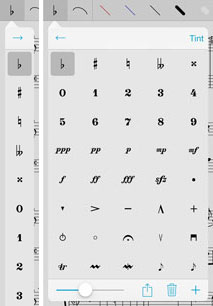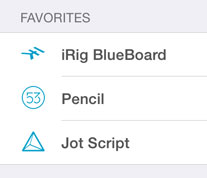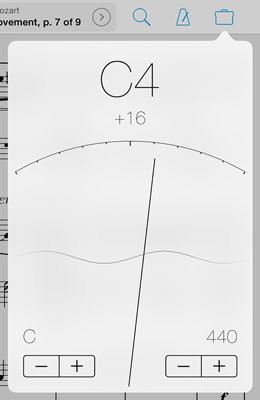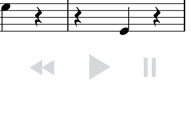Annotation is the heart of forScore, and we’re constantly looking for ways to improve not just the technologies that power it, but also the interface that defines it. With forScore 8, coming later this month, we’ve redesigned the annotation controls to refocus on efficiency and clarity. We’ve flattened a hierarchy of panels and popovers into a more utilitarian layout that reduces the number of taps required to annotate effectively.

Instead of picking your drawing presets from a list of names, they’re all on display along the toolbar so you can find the right one instantly and select it with a tap. If you want to edit it, tap a second time, and if you have more presets than fit on the page you can scroll left and right to see them all. Stamps and shapes work similarly, with a live preview of your current stamp or shape tinted and resized to match your settings. Tap once to select either tool, and select again to pick a new stamp or shape or to edit it.
 The stamps panel itself has been completely rewritten as a collection view that scrolls up and down freely instead of paging left and right, and it no longer requires an “edit” mode to rearrange, add, delete, or edit your stamps. We’ve also added a new layout that makes stamps accessible without covering up a significant portion of the page: tap the new arrow button in the top left-hand corner to shrink it down into a single column of stamps that fills up the screen vertically. Finally, when placing stamps on a page, last-minute movements made by lifting your finger are now ignored for improved accuracy.
The stamps panel itself has been completely rewritten as a collection view that scrolls up and down freely instead of paging left and right, and it no longer requires an “edit” mode to rearrange, add, delete, or edit your stamps. We’ve also added a new layout that makes stamps accessible without covering up a significant portion of the page: tap the new arrow button in the top left-hand corner to shrink it down into a single column of stamps that fills up the screen vertically. Finally, when placing stamps on a page, last-minute movements made by lifting your finger are now ignored for improved accuracy.
Text annotations got some improvements, too, with a new scaling option in the settings panel to ensure that text annotations line up consistently with your music in both portrait and landscape orientations. Since this affects existing annotations, it has only been enabled by default for new users. For other users, turning it on will make text annotations larger in landscape orientation than they have been previously, so some manual adjustments might be necessary.
These improvements join a list of great updates coming with forScore 8, and we’re very excited to get them out the door. If you haven’t had a chance to check them out yet, be sure to take a look at our previous posts unveiling a new media box, tuner, and devices panel.
We’re releasing a big update to forScore later this month, and this is the third in a series of in-depth looks we’ll be posting as we count down to its release. If you haven’t had a chance to yet, be sure to check out forScore 8’s new media box and tuner. That’s just the start, though, and today we’re really excited to unveil our next big thing. But first, a little background:
Bluetooth Smart, or Bluetooth LE is an extremely lightweight version of the same wireless technology that’s been around for years, but it uses a fraction of the power meaning both your peripherals and your iPad will last longer between charges. With forScore 8, we’ve added a centralized hub for you to connect to and manage certain peripherals that use this technology, a new “Devices” panel that you’ll find in the tools menu.
At launch, we’ll support IK Multimedia’s iRig BlueBoard, FiftyThree’s Pencil, and Adonit’s Jot Script. Of course, forScore already works with the iRig BlueBoard, but it currently requires an intermediary app to be running in the background.  Now, you’ll be able to skip that step and connect directly to this great page turner featuring four backlit pedals, two auxiliary ports, and long battery life.
Now, you’ll be able to skip that step and connect directly to this great page turner featuring four backlit pedals, two auxiliary ports, and long battery life.
We also knew from the start that we wanted to support some of the great stylus options out there. We began by working with Adonit and FiftyThree’s SDKs (software development kits), but realized that using them would quadruple forScore’s size and limit our ability to fix any issues that might arise. Instead, we sat down to create our own solution and ended up with something that worked similarly but only took up a tiny fraction of the resources.
It was a tough choice to make, since we know people buy these devices expecting a uniform experience across compatible apps and that we’d be giving up some of the benefits of having a more formal partnership with these companies, but ultimately we’d rather make forScore the best product it can be and we think this is how we do that. Now you’ll get an even better drawing experience, palm rejection so you can draw and write more naturally and, if you’re using the Pencil, just flip it around to erase like you would with a real pencil—it’s a real treat to use.

Be sure to check back with us soon, because great stylus support is just the first half of forScore 8’s brand new annotation experience.
 Our next big update is coming later this month, and we’re exploring some of the biggest features and enhancements in a series of posts that began with last week’s feature on the new media box. Today we’re taking a look at something entirely new, a built-in tuner.
Our next big update is coming later this month, and we’re exploring some of the biggest features and enhancements in a series of posts that began with last week’s feature on the new media box. Today we’re taking a look at something entirely new, a built-in tuner.
This new tuner is a no-nonsense utility that feels right at home with forScore’s pitch pipe and metronome, and uses a beautiful sine wave animation to give you a visual sense of focus by reducing amplitude as you zero in on your note. You can transpose if you’re using an instrument that requires it, and you can adjust the base frequency to fit your needs.
We think it’s a great new addition to forScore’s toolbox, and just one of the exciting new upgrades we’ll be unveiling over the next few weeks. Be sure to check back soon for more!
Next month we’ll be releasing our next big update, forScore 8. Instead of our typical “sneak peek” that packs in brief descriptions of all of the biggest new features, this time we’ll be posting a series of more focused updates so we can give each new upgrade a little more attention. We’re starting with a big visual update in forScore 8: the media box.

Instead of the old fixed-width black box, forScore’s new media box spans the entire width of the screen in both portrait and landscape orientations, giving you better precision when seeking or setting loop points. With forScore 7 we introduced the ability to slow down audio files, and with forScore 8 we’ve now extended that feature to work with tracks from your iTunes library as well.

The media box still appears and disappears with the rest of forScore’s controls, but now you can slide it down and out of the way (replacing the old collapsed artwork-only mode). We’ve also added an option to the settings panel that makes the rewind, play, and pause buttons mostly transparent and keeps them on-screen at all times.
It’s a great new experience, and it’s just the start of what’s coming in forScore 8. We’re very excited to show you some of the other great new features and improvements we’ve made, so be sure to check back soon as we count down to release day!
Late last year we told you about PageFlip’s Kickstarter campaign to help fund a new page turner model, the Firefly. If you’re in the market for a page turner you’ve got lots of great choices, but we’ve always loved our Cicada for its all-in-one form factor, price, and replaceable batteries. The Firefly takes these strengths and improves upon them decisively, and the results are well worth the cost.
The Firefly isn’t a huge departure from its smaller sibling; it looks similar and works how you’d expect, but the refinements add up. It’s heavier, first of all, which makes it more stable than the Cicada and gives it a good feeling of heft. It’s almost twice the weight, and a little more than the AirTurn BT-105’s standard configuration (two ATFS-2 switches and the pedal board).
It’s the same width as the Cicada but its pedals are stretched farther forward and angled downward, giving you a more comfortable and reliable target. Its pedals are also lighted (configurable), so you can find them in poorly-lit environments, and the mechanism feels much smoother while still giving you enough feedback to know when they’re engaged.
First impressions matter, of course, and in this arena a lot of page turners fall short. The Cicada’s code entry system for pairing is simple but not obvious, and the BT-105’s single color-changing LED is sure to drive you mad when things don’t work as expected. The Firefly includes the Cicada’s easy one-button reset and does away with the code, making pairing and re-pairing a breeze.
If you’ve been considering getting a page turner, be sure to check this one out. It’s a solid entry and definitely worth a look. Find out more at PageFlip.com.

 The stamps panel itself has been completely rewritten as a collection view that scrolls up and down freely instead of paging left and right, and it no longer requires an “edit” mode to rearrange, add, delete, or edit your stamps. We’ve also added a new layout that makes stamps accessible without covering up a significant portion of the page: tap the new arrow button in the top left-hand corner to shrink it down into a single column of stamps that fills up the screen vertically. Finally, when placing stamps on a page, last-minute movements made by lifting your finger are now ignored for improved accuracy.
The stamps panel itself has been completely rewritten as a collection view that scrolls up and down freely instead of paging left and right, and it no longer requires an “edit” mode to rearrange, add, delete, or edit your stamps. We’ve also added a new layout that makes stamps accessible without covering up a significant portion of the page: tap the new arrow button in the top left-hand corner to shrink it down into a single column of stamps that fills up the screen vertically. Finally, when placing stamps on a page, last-minute movements made by lifting your finger are now ignored for improved accuracy.



